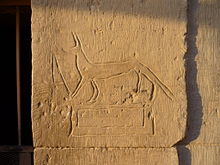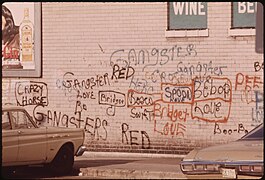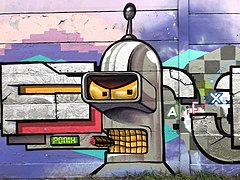LittleBigPlanet theme by Sjarper
Download: LittleBigPlanet_10.p3t
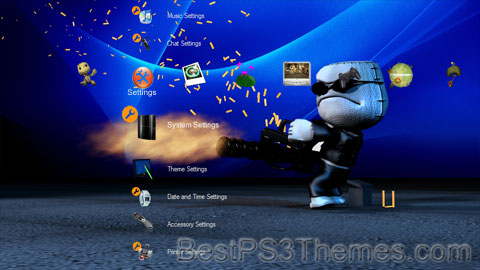
(6 backgrounds)
| LittleBigPlanet | |
|---|---|
 | |
| Genre(s) | Platform, endless running |
| Developer(s) | Media Molecule (2008-2014) SCE Studio Cambridge (2009) Supermassive Games (2010) XDev (2010-2012) Double Eleven (2012) Tarsier Studios (2012) United Front Games (2012) San Diego Studio (2012) Firesprite (2014) Sumo Digital (2014-2020) Exient Entertainment (2023) |
| Publisher(s) | Sony Interactive Entertainment PlayStation Mobile (2014) |
| Platform(s) | PlayStation 3 PlayStation Portable PlayStation Vita PlayStation 4 PlayStation 5 Windows |
| First release | LittleBigPlanet 27 October 2008 |
| Latest release | Ultimate Sackboy March 3, 2023 |
LittleBigPlanet (LBP - stylised as LittleBIGPlanet) is a puzzle platform video game series created and produced by British developer Media Molecule and published by Sony Interactive Entertainment. Most games in the series put a strong emphasis on user-generated content and are based on the series' tagline "Play, Create, Share". The tagline represents the three core elements of the series: playing alone or with others locally (on the same console) or online, creating new content using the in-game creation tools, and sharing creations and discoveries online with other players.
Tarsier Studios, Fireproof Games and Supermassive Games also contribute to the development of the PlayStation 3 games, creating in-game assets (downloadable content) including costumes, backgrounds, objects, and stickers. Some of these assets will also provide the player more tools and gadgets to use in the level editor.[1]
The series comprises six games across five gaming platforms. The series was launched in 2008 with the PlayStation 3 game LittleBigPlanet, which was followed in 2009 by a PlayStation Portable version of the same name, initially developed by Studio Liverpool[2] and later handed to SCE Studio Cambridge. The sequel to the PlayStation 3 version, LittleBigPlanet 2, was released in January 2011 alongside a smaller spin-off title called Sackboy's Prehistoric Moves. LittleBigPlanet PS Vita was developed by Tarsier Studios and Double Eleven, released in September 2012 for the PlayStation Vita. At E3 2014, Sony announced LittleBigPlanet 3, a PlayStation 4 instalment that was developed by Sumo Digital and released in November 2014.[3] The games are all published by Sony Computer Entertainment. The latest instalment for the LittleBigPlanet franchise titled Sackboy: A Big Adventure was revealed during the PS5 live event and released on the PlayStation 4 and PlayStation 5 in November 2020. A Windows version was released on 27 October 2022.[4]
On 17 January 2015, it was announced that all LittleBigPlanet servers in Japan would shut down on 31 July, along with the PlayStation Portable version and LittleBigPlanet Karting in late August in all regions. Due to attacks on the online servers, all LittleBigPlanet servers were taken down in May 2021 (the Vita version had remained closed since March).[5] The servers for the PS4 version of LittleBigPlanet 3 were brought back up on 13 September 2021, however, in the same announcement, it mentioned that the servers for LittleBigPlanet, LittleBigPlanet 2, LittleBigPlanet PS Vita and the PS3 version of LittleBigPlanet 3 will remain closed permanently.[6] On 8 January, 2024, it was announced that, presumably due to more attacks on the online servers, the servers for the PS4 version of LittleBigPlanet 3 were being temporarily closed while they investigate them.[7][8][9]
On 19 April 2024, the servers for the PlayStation 4 version of LittleBigPlanet 3 were permanently shut down due to ongoing technical issues.[10]
Gameplay[edit]
The core mechanics of the series revolve around its tagline, "Play, Create, Share".[11]
Play[edit]
In the first two instalments of the series, gameplay consist primarily of traditional two-dimensional look in a three-dimensional style platforming like jumping and avoiding obstacles to successfully navigate to the end of a level to win.[12] Since LittleBigPlanet 2, the series has included mini-games, including ones that do not follow the platformer genre. Most LittleBigPlanet games involve a player playing solo or co-operatively with friends to navigate through a level whilst collecting various "bubbles" along the way, which can take the form of either points or collectibles. In-game collectibles can be used in level creation or to customize Sackboy, the player character. There are also numerous co-operative parts of levels whereby certain prize bubbles can be earned. In LittleBigPlanet 3 and Sackboy: A Big Adventure, Collectables are also present, being used in various shops to purchase more costumes.
Create[edit]
The Create component primarily refers to level creation in the game, along with other features like character customisation. Players can create their own levels with the built-in level creator. Many items that are collected while playing through the story mode and from LittleBigPlanet's community can be used to help with level creation.[13] These levels can remain as the original LittleBigPlanet platforming gameplay, or they can include other game types, such as racing, fighting, shooting and sports.[12] The player can also make non-gaming creations such as music and films (commonly known in-game as cut-scenes).[14] In LittleBigPlanet 2, Sackbots were introduced to give players more control over non-player characters in their levels as well as make the levels in their entirety more intelligent. The creation technique introduced on the game gave the possibility for logic, and it gave the ability to build sets of machines and complex contraptions.[14]
[edit]
Lastly, the Share component relates to sharing creations with the game's community by uploading levels to the PlayStation Network. To-date there were an excess of ten million user-created levels available to play on the LittleBigPlanet server in the PlayStation 3 games.[15] After the release of LittleBigPlanet 2 and the LBP.me community website, the Share component also had a strong emphasis sharing discoveries. Players were encouraged to share levels they found with other players by writing reviews and comments in-game and by sharing links to creations' LBP.me pages via social networks.
Overview[edit]
The series takes place in a world known as LittleBigPlanet. Each curator is in charge of a part of LittleBigPlanet and they govern them independently. LittleBigPlanet has geography inspired by the real-life Earth. All games in the series follow the main protagonist Sackboy, a small anthropomorphic creature made of brown fabric with a zip fastener and button eyes. He can be customized to the player's liking using costumes that are either unlocked in the game or bought as downloadable content from the PlayStation Store. The player can control Sackboy's four emotions; happiness, sadness, worry and anger, each of which has three levels of intensity. The English language version of each game is narrated by Stephen Fry and in all formats Fry's scripts are written by Dean Wilkinson.
Games[edit]
| 2008 | LittleBigPlanet |
|---|---|
| 2009 | LittleBigPlanet (PSP) |
| 2010 | Sackboy's Prehistoric Moves |
| 2011 | LittleBigPlanet 2 |
| 2012 | LittleBigPlanet PS Vita |
| LittleBigPlanet Karting | |
| 2013 | |
| 2014 | Run Sackboy! Run! |
| LittleBigPlanet 3 | |
| 2015 | |
| 2016 | |
| 2017 | |
| 2018 | |
| 2019 | |
| 2020 | Sackboy: A Big Adventure |
| 2021 | |
| 2022 | |
| 2023 | Ultimate Sackboy |
Main series[edit]
LittleBigPlanet[edit]
The first game in the series was released on the PlayStation 3 platform in 2008 and was the first title developed by Media Molecule, under the name The Next Big Thing. The player controls Sackboy as he travels around the titular LittleBigPlanet, helping the eight creator curators of LittleBigPlanet with their problems in their own respective realms. Throughout the story, Sackboy tries to stop The Collector, one of the eight creator curators who has gone rogue, kidnapping the creations of LittleBigPlanet.[16] The game received widespread acclaim for its design, gameplay, and customization afforded to the player, particularly the built-in level editor. After its release, it received numerous industry awards.[17]
LittleBigPlanet 2[edit]
The second game in the series is a direct sequel to the first LittleBigPlanet and was developed by Media Molecule for the PlayStation 3 for a release in 2011. The sequel saw a major shift in the direction of the series, going from a primarily traditional platform game in the first two entries to a more varied style of gameplay called a "platform for games". The second game gave players a wider variety of options when it came to level design, which saw the creation of levels other than platforming such as racing, puzzles, and fighting games.[18] Following the events of the first two entries in the series, the game takes place when an antagonist known as the Negativitron invades LittleBigPlanet and begins to suck up all its inhabitants. Sackboy must team up with a secret organization known as "The Alliance", led by Larry Da Vinci, to save LittleBigPlanet from the Negativitron.[19] The game also supported the PlayStation Move, with an update post-launch.
LittleBigPlanet 3[edit]
LittleBigPlanet 3 is a game for the PlayStation 3[20][21][22] and PlayStation 4. Announced at E3 2014, it was developed by Sumo Digital and was released in November 2014. In the game, Sackboy is transported to another world, Bunkum, where he has to awaken its three missing heroes, OddSock, Toggle and Swoop, who are new playable characters. Sackboy travels through different worlds in order to free the 3 new characters and stop Newton.[23]
Handheld[edit]
LittleBigPlanet (PlayStation Portable)[edit]
A portable entry of the series was developed primarily by SCE Studio Cambridge in association with Media Molecule for the PlayStation Portable. The game, released in 2009, shared the same name as the original game; however, it was not a port of the PlayStation 3 game, but rather a new entry in the series. It has a story-mode with levels and features many of the same mechanics of its PlayStation 3 counterpart, such as customizations, albeit without the multiplayer component of the game. The game takes place after the events of the PlayStation 3 version of LittleBigPlanet, in which The Collector has been defeated. A carnival is being held and Sackboy decides to go around the world to invite the eight curators of LittleBigPlanet to the carnival whilst finding materials for his own carnival float.[24]
LittleBigPlanet PS Vita[edit]
The fourth game in the series was developed by Tarsier Studios, Double Eleven, and XDev for the PlayStation Vita handheld and had a 2012 release.[25] The game features the same core mechanics from LittleBigPlanet 2, with the focus being on a "platform for games" rather than a platformer like previous entries in the series before LittleBigPlanet 2. The game utilizes the unique controls of the PlayStation Vita by using its multi-touch touchscreen and its rear touchpad to navigate through various obstacles in stages as well as for level creation by users.[26] The game supports cross-buy of DLC costume packs between LittleBigPlanet 2, as well as LittleBigPlanet Karting.
Spinoff games[edit]
LittleBigPlanet Karting[edit]
LittleBigPlanet Karting is a kart racing game developed by United Front and San Diego Studio in conjunction with series creator Media Molecule for the PlayStation 3.[27] In its story mode, the player ventures through worlds including: LittleBigPlanet, Monster Islands, Victoria's Laboratory, The Progress Emporium, Eve's Asylum, The Space Bass, and Hoard, Sweet Hoard, to put an end to the Hoard racers, who snatch many pieces of the different planets to stash them in the Garage at the End of the Universe. Sony Entertainment America shut down the North American LittleBigPlanet Karting online servers on 31 August 2016.[28]
Sackboy's Prehistoric Moves[edit]
The game was developed by XDev as a spin-off from the LittleBigPlanet series utilizing the PlayStation Move on the PlayStation 3. It was released in December 2010, as a downloadable title from the PlayStation Store and was later bundled with LittleBigPlanet 2. The game was described as a "demo" and featured 10 prehistoric inspired story levels. In the game, Sackboy must save Little Big Planet from the T-Rex. Unlike the main games, which can be played as a single-player experience, the game required a minimum of two players to work.[29] This was due to the main mechanics of the spin-off whereby one player would control Sackboy traditionally using the gamepad for platforming while a second player had to use a PlayStation Move similar to a pointer to move obstacles and objects out of the way in order to successfully navigate a level.[30]
Run Sackboy! Run![edit]
Run Sackboy! Run! is a free-to-play endless running game developed by Firesprite and published by PlayStation Mobile that was released on iOS on 30 October 2014,[31] Android on 17 December 2014[32] and PlayStation Vita on 31 March 2015.[33] The game has no real plot, except for Sackboy running through Craftworld from the Negativitron. The game awarded players with exclusive costumes for LittleBigPlanet 3 (which was released at a similar time) by reaching point goals and collecting stickers.[34]
LittleBigPlanet Hub[edit]
LittleBigPlanet Hub is an unreleased free-to-play game for the PlayStation 3.[35] It was planned to be a downloadable title from the PlayStation Store which would have allowed players to create levels and play a curated selection of community levels from LittleBigPlanet and LittleBigPlanet 2 as well as 16 levels from the games' story modes. LittleBigPlanet Hub would also have contained weekly challenges, not found in other LittleBigPlanet games. Downloadable content purchased in other games were to be compatible with LittleBigPlanet Hub, and users were rumoured to be also able to access additional content from the PlayStation Store.[citation needed]
Since its announcement in August 2013, no further details about LittleBigPlanet Hub were revealed.[36] In February 2024, a beta tester posted a video showing gameplay from a beta build onto YouTube, and shortly afterwards, with assistance, dumped it online for download. This makes the build playable through unofficial means, such as emulations like RPCS3 or PlayStation 3 homebrew.[37]
Sackboy: A Big Adventure[edit]
Sackboy: A Big Adventure is a 2020 platform game developed by Sumo Digital and published by Sony Interactive Entertainment for the PlayStation 5 and the PlayStation 4. It was announced at the PlayStation 5 reveal event on June 11, 2020, and was released on November 12, 2020; a version for Windows was released on October 27, 2022, marking the series's first release on PCs. Unlike previous LittleBigPlanet entries with 2.5D platforming, A Big Adventure features a range of perspectives and 3D movement.
Ultimate Sackboy[edit]
Ultimate Sackboy is a free-to-play endless running game developed by Exient Entertainment and released on mobile on 21 February 2023. It is the first LittleBigPlanet game to feature limited-time paid subscriptions known as "Marathons." In contrast to Run Sackboy! Run!, it adopts the style from Sackboy: A Big Adventure and is played in 3D.
Reception[edit]
| Game | Metacritic |
|---|---|
| LittleBigPlanet (PlayStation 3) | 95/100[38] |
| LittleBigPlanet (PlayStation Portable) | 87/100[39] |
| Sackboy's Prehistoric Moves | 66/100[40] |
| LittleBigPlanet 2 | 91/100[41] |
| LittleBigPlanet PS Vita | 88/100[42] |
| LittleBigPlanet Karting | 74/100[43] |
| LittleBigPlanet 3 | 79/100[44] |
| Run Sackboy! Run! | 65/100[45] |
| Sackboy: A Big Adventure | 80/100[46] |
| Ultimate Sackboy | 57/100[47] |
Most of the games in the series have been well received by critics with the LittleBigPlanet on PlayStation 3 and PlayStation Portable gaining Metacritic scores of 95/100[38] and 87/100[39] respectively. LittleBigPlanet 2 garnered nearly as much acclaim as the first game, with an average score of 91/100.[48] LittleBigPlanet PS Vita also received very positive reviews and was the highest-ranked PS Vita game at the time of its release with an average score of 88/100.[49] However, the release of LittleBigPlanet 3 did not receive critical acclaim, garnering a mostly positive average of 79/100.[50] Critically, LittleBigPlanet Karting is the worst-performing major game in the series so far but still gained a "mixed or average" Metacritic score of 74/100.[51] However, the mobile game Run Sackboy! Run! performed worse, with a Metacritic score of 65/100.[52] Additionally, the character of Sackboy is often seen as a PlayStation mascot.[53] In 2011, readers of Guinness World Records Gamer's Edition voted Sackboy as the 50th-top video game character of all time.[54]
References[edit]
- ^ "Introducing the Extended LittleBigPlanet Family - Media Molecule - We make games". Media Molecule. Archived from the original on 21 February 2016. Retrieved 6 December 2010.
- ^ "LittleBigPlanet coming to PSP - CVG". Computerandvideogames.com. 8 April 2008. Archived from the original on 15 April 2014. Retrieved 14 June 2014.
- ^ "LittleBigPlanet 3 coming to PS4 this November". 10 June 2014. Archived from the original on 14 July 2014. Retrieved 10 June 2014.
- ^ "Sackboy: A Big Adventure coming to PC on October 27". Gematsu. 29 September 2022. Retrieved 29 September 2022.
- ^ "LittleBigPlanet Servers Taken Down After Hackers Post Hate Speech". PlayStation LifeStyle. 24 May 2021. Archived from the original on 13 September 2021. Retrieved 13 September 2021.
- ^ Yin-Poole, Wesley (13 September 2021). "Sony shuts down online for older LittleBigPlanet games "to protect the community"". Eurogamer. Archived from the original on 2 April 2022. Retrieved 13 September 2021.
Macintosh
Macintosh theme by Tyler Senn
Download: Macintosh.p3t
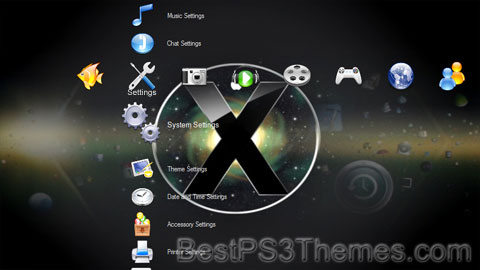
(4 backgrounds)
Redirect to:
This page is a redirect. The following categories are used to track and monitor this redirect:- From a page move: This is a redirect from a page that has been moved (renamed). This page was kept as a redirect to avoid breaking links, both internal and external, that may have been made to the old page name.
When appropriate, protection levels are automatically sensed, described and categorized.- From a former name: This is a redirect from a former name or working title of the target topic to the new name that resulted from a name change.
Gran Turismo 5 Muted
Gran Turismo 5 Muted theme by Anthony Cook
Download: GranTurismo5Muted.p3t
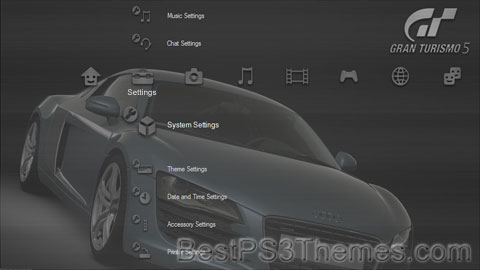
(4 backgrounds)
P3T Unpacker v0.12
Copyright (c) 2007. Anoop MenonThis program unpacks Playstation 3 Theme files (.p3t) so that you can touch-up an existing theme to your likings or use a certain wallpaper from it (as many themes have multiple). But remember, if you use content from another theme and release it, be sure to give credit!
Download for Windows: p3textractor.zip
Instructions:
Download p3textractor.zip from above. Extract the files to a folder with a program such as WinZip or WinRAR. Now there are multiple ways to extract the theme.
The first way is to simply open the p3t file with p3textractor.exe. If you don’t know how to do this, right click the p3t file and select Open With. Alternatively, open the p3t file and it will ask you to select a program to open with. Click Browse and find p3textractor.exe from where you previously extracted it to. It will open CMD and extract the theme to extracted.[filename]. After that, all you need to do for any future p3t files is open them and it will extract.
The second way is very simple. Just drag the p3t file to p3textractor.exe. It will open CMD and extract the theme to extracted.[filename].
For the third way, first put the p3t file you want to extract into the same folder as p3textractor.exe. Open CMD and browse to the folder with p3extractor.exe. Enter the following:
p3textractor filename.p3t [destination path]Replace filename with the name of the p3t file, and replace [destination path] with the name of the folder you want the files to be extracted to. A destination path is not required. By default it will extract to extracted.filename.Gran Turismo 5 Dark Style
Gran Turismo 5 Dark Style theme by Anthony Cook
Download: GranTurismo5DarkStyle.p3t
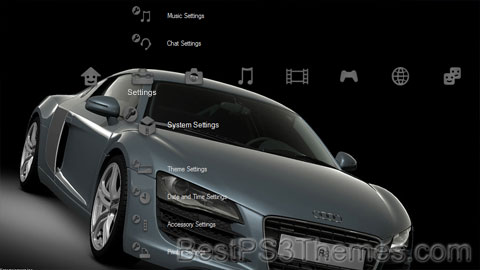
(4 backgrounds)
P3T Unpacker v0.12
Copyright (c) 2007. Anoop MenonThis program unpacks Playstation 3 Theme files (.p3t) so that you can touch-up an existing theme to your likings or use a certain wallpaper from it (as many themes have multiple). But remember, if you use content from another theme and release it, be sure to give credit!
Download for Windows: p3textractor.zip
Instructions:
Download p3textractor.zip from above. Extract the files to a folder with a program such as WinZip or WinRAR. Now there are multiple ways to extract the theme.
The first way is to simply open the p3t file with p3textractor.exe. If you don’t know how to do this, right click the p3t file and select Open With. Alternatively, open the p3t file and it will ask you to select a program to open with. Click Browse and find p3textractor.exe from where you previously extracted it to. It will open CMD and extract the theme to extracted.[filename]. After that, all you need to do for any future p3t files is open them and it will extract.
The second way is very simple. Just drag the p3t file to p3textractor.exe. It will open CMD and extract the theme to extracted.[filename].
For the third way, first put the p3t file you want to extract into the same folder as p3textractor.exe. Open CMD and browse to the folder with p3extractor.exe. Enter the following:
p3textractor filename.p3t [destination path]Replace filename with the name of the p3t file, and replace [destination path] with the name of the folder you want the files to be extracted to. A destination path is not required. By default it will extract to extracted.filename.Gran Turismo 5 Prologue
Gran Turismo 5 Prologue theme by Anthony Cook
Download: GranTurismo5Prologue.p3t
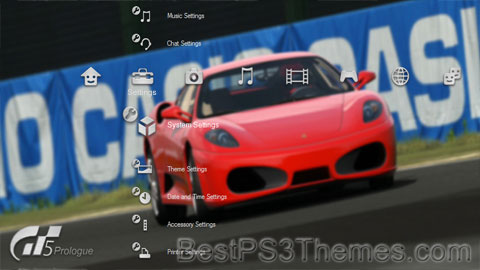
(5 backgrounds)
Gran Turismo 5 Prologue  European box art
European box artDeveloper(s) Polyphony Digital Publisher(s) Sony Computer Entertainment Designer(s) Kazunori Yamauchi Series Gran Turismo Platform(s) PlayStation 3 Release Genre(s) Racing simulation Mode(s) Single player, multiplayer Gran Turismo 5 Prologue (グランツーリスモ5 プロローグ, Guran Tsūrisumo 5 Purorōgu) is a 2007 racing simulation video game developed by Polyphony Digital and published by Sony Computer Entertainment for the PlayStation 3. It is the eighth overall installment in the Gran Turismo series. Gran Turismo 5 Prologue is a precursor to Gran Turismo 5, in celebration of the series' tenth anniversary.[5]
The game has sold 5.09 million copies worldwide, making it the second highest-selling PlayStation 3 exclusive title after its successor, Gran Turismo 5.[6]
Gameplay[edit]

GT5 gaming area at the 2008 Taipei Game Show This game introduced the ability to race with up to 16 cars at once to the Gran Turismo series. According to game developer Polyphony Digital, the NPC's AI has also improved from previous Gran Turismo games.[7]
New to the series is the realistic in-car view feature. It includes functioning speedometers, odometers, reflecting rear-view mirrors, wing mirrors and real-time in-car lighting effects, such as shadows. Players driving with either the control pad or the steering wheel can look left and right in the cockpit of the car by using the D-pad. This function can be mapped to other buttons on the controller if preferred. Any PlayStation 3 - compatible steering wheel works with Gran Turismo 5 Prologue. Three viewing modes show the car from exterior angles. The fourth, called "cockpit mode", includes the driver's perspective from the interior of the car looking past the steering wheel to the track and is available only for "premium" cars.[8]
The Spec II update brings Drift Mode (similar to that of Gran Turismo HD Concept), car tuning adjustments, and head to head two-player racing offline.[9]
Online[edit]
Gran Turismo 5 Prologue is the first mass-produced Gran Turismo game to feature online multiplayer.[10] Up to 16 players can play online at once in GT5 Prologue. Since Gran Turismo 5's development cycle was so long, GT5 Prologue's servers were online for two years even though the game only served as a prologue.[11] Gran Turismo 4 for the PlayStation 2 was intended to contain an online component, but this feature was pulled before the game's release to avoid further delays; a beta of GT4 online was even released.[12] Gran Turismo HD Concept also contained an online Time Trial feature.[13]
The latest update, entitled Spec III, added new cars and further improvements to the game and was released in October 2008. A separate disc was also released in Japan that included all updates, including Spec III. The Platinum release of the game, originally unveiled in Europe, also comes with the Spec III update.[14]
Interface[edit]
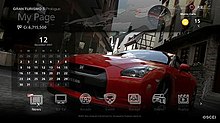
My Page interface in Gran Turismo 5 Prologue (Japanese version 1.01) The game has a brand new interface called 'My Page' that acts as the player's personalized menu for the game. When the game starts up, the player is taken straight to this interface, and the currently selected car is displayed on the screen in a picturesque real-life location. The vehicle is set in a Full HD advanced 3D environment with a 360° camera and the GUI's real-time zoom-in function is enabled.
In the Japanese version, the 'My Page' interface includes:
- News: a regularly updated online log archiving game news such as newly added Online Event Races, VOD programs or technical information such as server maintenance schedule.
- GT-TV: a Video-on-demand service was offering free of charge and playable HD content. Available videos are real-life car-related videos such as new model tests, Auto show reports, car documentaries, or special event videos. Game videos such as opening and ending movies are also available for download from the Blu-ray Disc to the console's HDD once unlocked. However, premium content was discontinued on December 29, 2009, to move focus to the release of the full game.
- Online: Online Events consist of either multiplayer races from 2 up to 16 players (some of which are world scale), or online Time Trial events. Each event is limited in time, once finished, a ranking board shows the most successful players' scores. Top players' replay files are made available for download as ghost replays. Each week new events with their specific parameters (car class, tire types, assistance level, etc.) are added to the list while older are closed.
- Ranking: an online ranking board for each course archiving the best record per track and car.
- Arcade: a single race mode is allowing the player to choose a track to race on board the currently selected car and to compete against 15 AI-controlled cars. Credits are not earned in this mode.
- 2P Battle: an offline two-player split-screen mode.
- Event: Event Races are championships, time trials and mission races against the AI in various classes. Once completed in Gold, Silver, or Bronze level, new, harder classes are made available. Credits are earned by the player as he wins the races in top positions. Three basic classes are available Class C, B, and A. Once Class A is completed, the game's ending movie is available for download in GT-TV, and a bonus class called Class S is added.
- Garage: where the players' cars can be viewed, raced and also sold to earn credits.
- Dealerships: where the player can buy a new car using credits earned from Event races. Various models from world-famous automakers are available for purchase in the showroom. Some automakers have their Event race consisting of a one-make race for a specific model. Brand related News is regularly provided through online updates.
- Replay: saved or downloaded replays are available for watching.
- Option: various options settings for the game.
- Manual: the game's Playing Manual is displayed on-screen. The Manual is almost always updated with a software update.
- Save: allows to record the game when the auto-save feature is disabled.
When the user's PlayStation Network account is signed off, online content related icons are disabled (1, 2, 3 and 4). The Museum is activated from the 'My Page' interface once the game is in rolling demo mode. This feature provides the players with automakers' background and history.
Updates[edit]
Updates were available on game boot through online download, all free. Game content such as new cars, game modes or GT-TV videos were added with each update. Some elements such as BGMs are regionally exclusive due to licensing issues.[15] Once Polyphony Digital begun to focus on Gran Turismo 5, it stopped applying updates to GT5 Prologue.[16]
GT-TV[edit]
The Gran Turismo TV feature was introduced in the free demo version. The VOD service was activated on October 22, 2007, providing free SD trailers for three upcoming GT-TV programs,[17] Super GT ("Climax Digest"), D1 Grand Prix ("Top of the Drifting World") and Best Motoring ("Best Motoring Trailer").[18][17] From October 22 to November 30 three GT-TV exclusive HD videos featuring game producer Kazunori Yamauchi premiered in the demo: "First Impression: Lancer Evolution X",[19] "Tokyo Motor Show 2007"[20] and "GT-R Legend Inside Story part I".[21]
The demo was removed from the Japanese PlayStation Store on November 30[22] and its online functions ended on December 6,[23] however all issued VOD videos were later re-released in the game's retail version through updates, except the SD trailers. "The GT-R Legend Inside Story" part 1 documentary was included in the Blu-ray Disc though.[24] It was later completed by parts II & III, both released through GT-TV updates.
The first episode of the BBC's Top Gear series 6 was available for free since March 31.[25][26] In the meantime, five videos released in December 2007 have been removed. On April 1, two promotion videos for Super GT ("Fascination for the Super GT") and D1 Grand Prix ("The Drifting World") were added.[27] The first trailer for Video Option ("What is the Video Option?") was also included announcing upcoming releases for this magazine.[28]
On August 1, 2008, GT-TV was completely overhauled with a new interface, layout, and the launch of the PPV (pay-per-view) service. The "GT-R Legend Inside Story (all parts)", "'08 Nurburgring 24h Introduction" and "First Impression Lancer Evolution X" videos stayed free-of-charge. "Fascination for the Super GT", "The Drifting World", and "What is The Video Option?" videos were taken off of GT-TV.[29] The new update added new PPV videos; 8 Top Gear videos, 1 Option video, 1 Super GT video, D1 Grand Prix video, 1 Gran Turismo video and 1 Best Motoring video. Also kept were the opening and ending movies, also staying free-of-charge. All PPV videos were released at a reduced price at the launch of the service.[30] When asked whether the GT-TV service could come to the PSP, Yamauchi answered, "We definitely want to do that in the future", suggesting that watching GT-TV on the move could become a reality in the future, but this never happened ultimately.[31]
Cars[edit]
The Japanese release in December 2007 featured 37 stock cars (plus the uncredited GT-R "Black Mask" returning from the free playable demo) from various Japanese, European and American manufacturers including Nissan, Ferrari, and Ford.[32] While GT3 and GT4 did have Formula One cars, GT5 Prologue was the first of the series to feature a fully licensed F1 car, the F2007.
The Spec II update added new manufacturers, more stock cars and introduced racing cars and tuned cars. The update brought the total number of playable cars to 71.[33] The North American version of Gran Turismo 5 Prologue brought additional stock and tuned cars, increasing the game's car list to 76 credited cars.[34]
Tracks[edit]
Four circuits located in Japan, Europe, and North America are included in the original game, plus two fictitious tracks: The High-Speed Ring and Eiger/Eiger Nordwand. In the absence of suitable roads in the real-life location around Kleine Scheidegg and the Eiger, the game developers created the track based on an actual hiking trail.
Each track is available in two different layouts. London, High-Speed Ring, and Eiger Nordwand are available in the forward and reverse directions. The Fuji International Speedway is available in both "F1" and "GT" variation; the Daytona International Speedway has both the Oval and Road Course layouts; the Suzuka Circuit has a shorter layout known as the East Course.[35] Each real-life circuit has an HD video "Course Guide" that documents the location with actual footage and commentary text.
Spec II update[34] adds the Gran Turismo franchise's classic High-Speed Ring fictitious circuit (available in both forward and reverse version) which brings the total number of tracks to six (twelve different layouts).[36]
Input device support[edit]
The Gran Turismo 5 Prologue free playable demo was the first PlayStation 3 release supporting both Dual Shock 3 controller vibration and racing wheels force feedback feature. On February 20, 2008, Logitech announced a new Gran Turismo official wheel, the Driving Force GT to be launched in May to coincide with the game's western release.[37] Previous official Gran Turismo wheels are supported, which include the Driving Force Pro, GT Force, Driving Force and Driving Force EX. Limited support for the Logitech G25 Racing Wheel is available; the wheel is not officially supported, but it is possible to re-map the button layout via the Driving Force Pro setup screen[38] and the clutch can be enabled by pressing the triangle button at the start of each race, as soon as the player has control of the car.[39] Support for the Logitech G27 is also limited, for example, the paddle shifts do not work in-game, although the paddle shifts signals are detected (up and down) in the controller configuration screen.
Release[edit]
Japanese PSN demo[edit]
A free demo (グランツーリスモ5 プロローグ 無料体験版) was made available for download between October 20 and November 30, 2007[40] in the Japanese PlayStation store with the Suzuka Circuit and seven playable cars.[41] The demo unlocked cars as they were unveiled at the 40th Tokyo Motor Show. This demo replaced Gran Turismo HD Concept that was removed from the Japanese PlayStation Store on September 30.[42]
The demo initially had four playable cars from various Japanese and European manufacturers. The remaining three cars (Mazda ATENZA Sport '07, Lexus IS-F '07 and Subaru Impreza WRX STI '07) were unlocked as each one was unveiled at the Tokyo Motor Show. The show also unveiled the release of the Nissan GT-R '07 (replacing the "GT-R Black Mask" with its defining panels concealed).[43] The Black Mask was removed from the car section on October 23 to coincide with its official unveiling at the Tokyo Motor Show and was subsequently made available the following day.
SEMA Show 2007 demo[edit]
The North American version of Gran Turismo 5 Prologue demo was unveiled at Sony's booth during the 2007 SEMA Show in Las Vegas, Nevada.[44] Compared with the Japanese demo this new version had American cars (Dodge Viper GTS '02 and Ford Mustang V8 Coupe Premium '07) and tracks (Daytona International Speedway), these were included but not playable in the PSN demo. An American tuner car, the Art Morrison Corvette '60 SEMA version 2006, was added to the selectable vehicles.[44] This vehicle was later added to the retail game with update "Spec II".
Downshift Session 2008[edit]
This was an event held in October by Polyphony Digital to celebrate ten years of Gran Turismo. The main attraction in the show was Gran Turismo 5 Prologue running at a resolution of 3840x2160. The game normally runs at 60 FPS and 1920x1080 resolution. The game needed four PlayStation 3 consoles to run, and it was projected onto a 220-inch (5.6 m) screen using an expensive Sony projector. Each PS3 handled the rendering of one-quarter of the screen. With one PS3 system, approximately 2.1 million pixels would be displayed, but with this special high-resolution display, approximately 8.3 million pixels were displayed. A separate demo ran with the original resolution but at 240 FPS.[45]
Release with 80 GB PlayStation 3 in Japan[edit]
On October 9, 2008, Gran Turismo 5 Prologue Spec III was announced to be released for a limited time only, bundled with the new 80GB PS3 model released only in Japan. The new model had a choice of 3 colors; black, silver, and white, and came with the DualShock 3 controller as standard. Spec III introduced gameplay improvements and 3 new cars. The new packaging has also been shown, showing the GT by Citroën car on the front instead of the Nissan GT-R. The bundle was released on October 30.[46]
Documentary[edit]
Beyond the Apex is an 18-minute GT-TV documentary included in the Blu-ray version of the North American release of Gran Turismo 5 Prologue. This documentary was filmed and edited over four months by director Greg Harvey.[47] It features behind-the-scenes footage of the development of the game along with an interview with series creator, Kazunori Yamauchi.[48]
Soundtrack[edit]
A Gran Turismo 5 Prologue soundtrack was released in Japan on February 20, 2008. The CD is published by Village Music and includes 18 tracks.
The "Moon Over the Castle" theme song from the Gran Turismo series is featured, arranged and performed by Vince DiCola. DiCola stated in an interview with Music4Games that he recorded two versions of the theme, one for use in-game and the other for the soundtrack album.[49] This new version of the song was re-recorded in Los Angeles.[50]
Reception[edit]
ReceptionAggregate score Aggregator Score Metacritic 80/100[51] Review scores Publication Score Edge 7/10[52] Eurogamer 8/10[53] PSM3 8.7/10[54] Gran Turismo 5: Prologue received "generally favorable" reviews, according to review aggregator Metacritic.[51] According to SCEE's ThreeSpeech blog, the game has reached the one million mark in pre-orders from PAL territories making it the first PlayStation 3 game to reach Platinum status before its release.[55] Hyper's Eliot Fish commends the game for "looking and feeling fantastic". However, he criticizes it for having "no damage model".[56]
By April 30, 2008, Gran Turismo 5 Prologue had shipped 2.23 million worldwide according to Sony Computer Entertainment and Polyphony Digital, with 270,000 units in Japan, 550,000 in North America, 1.38 million in Europe, and 30,000 in Asia.[2] As of August 2009, Gran Turismo 5 Prologue has shipped 3.94 million copies worldwide, with 690,000 copies in Japan, 820,000 in North America, 2.33 million in Europe, and 100,000 in Southeast Asia.[57]
Gran Turismo 5 Prologue received a "Platinum" sales award from the Entertainment and Leisure Software Publishers Association (ELSPA),[58] indicating sales of at least 300,000 copies in the United Kingdom.[59] By December 2011, the games had sold 5.34 million copies; making it the second highest-selling PlayStation 3 title of all time being beaten by its successor, Gran Turismo 5.[60]
References[edit]
- ^ a b c ""Gran Turismo" Series Software Title List". Polyphony Digital. June 2009. Archived from the original on 2007-02-06. Retrieved 2009-08-12.
- ^ a b "Gran Turismo Series Shipment Exceeds 50 Million Units Worldwide" (Press release). Sony Computer Entertainment. 2008-05-09. Archived from the original on 2008-09-16. Retrieved 2008-10-10.
- ^ Games Release Schedule Archived January 13, 2008, at the Wayback Machine
- ^ Bramwell, Tom (2008-03-11). "European GT5 Prologue dated, priced". Eurogamer. Retrieved 2008-03-11.[permanent dead link]
- ^ "Gran Turismo 5 Prologue". PlayStation. Retrieved 2020-05-27.
- ^ "Polyphony Digital Software Title List". Archived from the original on 2007-02-06. Retrieved 2009-08-12.
- ^ Gran Turismo 5 Prologue official website - Introduction
- ^ "Review: Gran Turismo 5 is Premium Class". 27 November 2010.
- ^ DIGITAL, POLYPHONY. "Gran Turismo".
- ^ "Introduction - Gran Turismo 5 Prologue". Retrieved 2010-11-01.
- ^ "GT5 Online Teams/Leagues". Retrieved 2010-11-01.
- ^ Gran Turismo 4#Online test version
- ^ Gran Turismo HD Concept#Game modes
- ^ A Statement from Sony on Gran Turismo 5 Prologue 28 Mar. "A Statement from Sony on Gran Turismo 5 Prologue". Threespeech.com. Archived from the original on 2008-09-20. Retrieved 2011-07-18.
{{cite web}}:|author=has generic name (help)CS1 maint: numeric names: authors list (link) - ^ Jeff Haynes (2008-03-28). "New GT5 Prologue Details". Uk.ps3.ign.com. Retrieved 2011-07-18.
Rolex
Rolex theme by Paja
Download: Rolex.p3t
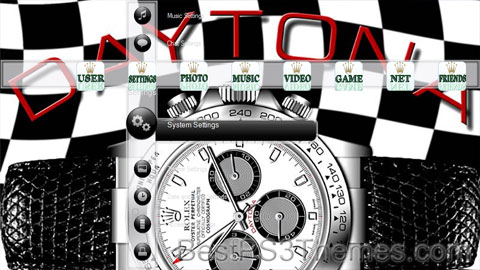
(1 background)
Rolex SA 
 Headquarters in Geneva, Switzerland
Headquarters in Geneva, SwitzerlandFormerly Wilsdorf and Davis (1905–1919)
Rolex Watch Co. Ltd (1919–1919)
Montres Rolex SA (1919–1920)Company type Société anonyme Industry Watchmaking Founded 1905 in London Founders - Hans Wilsdorf
- Alfred Davis
Headquarters , Area servedWorldwide Key peopleJean-Frédéric Dufour (CEO) Products Watches Production output1.05 million pieces (2021)[1] Revenue $13 billion (2021)[2] Owner Hans Wilsdorf Foundation Number of employees30,000 Subsidiaries Montres Tudor SA
Bucherer AGWebsite rolex.com Rolex SA (/ˈroʊlɛks/) is a Swiss watch brand and manufacturer based in Geneva, Switzerland.[3] Founded in 1905 as Wilsdorf and Davis by German businessman Hans Wilsdorf and his brother-in-law Alfred Davis in London, the company registered Rolex as the brand name of its watches in 1908 and became Rolex Watch Co. Ltd. in 1915.[4][5][6][7] After World War I, the company moved its base of operations to Geneva because of the unfavorable economy in the United Kingdom. In 1920, Hans Wilsdorf registered Montres Rolex SA in Geneva as the new company name (montre is French for clock or watch); it later became Rolex SA.[3][5][8][9] Since 1960, the company has been owned by the Hans Wilsdorf Foundation, a private family trust.[6][10][11]
Rolex SA and its subsidiary Montres Tudor SA design, make, distribute, and service wristwatches sold under the Rolex and Tudor brands. In 2023, Rolex agreed to acquire its longtime retail partner Bucherer,[12][13] and in 2024, Rolex began construction of a new headquarters on Fifth Avenue in Midtown Manhattan, New York City, near Billionaires' Row.[14]
History[edit]
Early history[edit]

A clock near the Congressional Country Club manufactured by Rolex 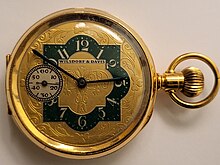
A Wilsdorf & Davis pocket watch. Wilsdorf & Davis was the precursor to what would become Rolex Alfred Davis and his brother-in-law Hans Wilsdorf founded Wilsdorf and Davis, the company that would eventually become Rolex SA, in London in 1905.[15] Wilsdorf and Davis's main commercial activity at the time involved importing Hermann Aegler's Swiss movements to England and placing them in watch cases made by Dennison and others. These early wristwatches were sold to many jewellers, who then put their own names on the dial. The earliest watches from Wilsdorf and Davis were usually hallmarked "W&D" inside the caseback.
In 1908, Wilsdorf registered the trademark "Rolex", which became the brand name of watches from Wilsdorf and Davis. He opened an office in La Chaux-de-Fonds, Switzerland.[5][15][16] Wilsdorf wanted the brand name to be easily pronounceable in any language, and short enough to fit on the face of a watch.[4][17] He also thought that the name "Rolex" was onomatopoeic, sounding like a watch being wound.[4][17]
During World War I, Rolex manufactured trench watches.[18][better source needed] In November 1915, the company changed its name to Rolex Watch Co. Ltd.[7] In 1919, Hans Wilsdorf moved the company from England to Geneva, Switzerland, because of heavy post-war taxes levied on luxury imports and high export duties on the silver and gold used for the watch cases. In 1919 the company's name was officially changed to Montres Rolex SA and later in 1920 to Rolex SA.[9][11][15]
With administrative worries attended to, Wilsdorf turned the company's attention to a marketing challenge: the infiltration of dust and moisture under the dial and crown, which damaged the movement. To address this problem, in 1926 a third-party casemaker produced a waterproof and dustproof wristwatch for Rolex, giving it the name "Oyster". The original patent attributed to Paul Perregaux and Georges Peret, that allowed the watch to be adjusted while maintaining protection from water ingress was purchased by Rolex and heavily marketed.[19] The watch featured a hermetically sealed case which provided optimal protection for the movement.[20]
As a demonstration, Rolex submerged Oyster models in aquariums, which it displayed in the windows of its main points of sale. In 1927, British swimmer Mercedes Gleitze swam the English Channel with an Oyster on her necklace, becoming the first Rolex ambassador. To celebrate the feat, Rolex published a full-page advertisement on the front page of the Daily Mail for every issue for a whole month proclaiming the watch's success during the ten-hour-plus swim.[20]
In 1931, Rolex patented a self-winding mechanism called a Perpetual rotor, a semi-circular plate that relies on gravity to move freely. In turn, the Oyster watch became known as the Oyster Perpetual.[20]
Upon the death of his wife in 1944, Wilsdorf established the Hans Wilsdorf Foundation, a private trust, in which he left all of his Rolex shares, ensuring that some of the company's income would go to charity. Wilsdorf died in 1960, and since then the trust has owned and run Rolex SA.[11]
Charitable status[edit]
The Hans Wilsdorf Foundation, which privately owns Rolex SA, is a registered Swiss charitable foundation and pays a lower tax rate.[21] In 2011, a spokesman for Rolex declined to provide evidence regarding the amount of charitable donations made by the Wilsdorf Foundation, which brought up several scandals due to the lack of transparency.[21] In Geneva where the company is based, it is said to have gifted, among many things, two housing buildings to social institutions of Geneva.[22]
Subsidiaries[edit]

Wristwatch Tudor Prince Date Day (ref. 76200) Rolex SA offers products under the Rolex and Tudor brands. Montres Tudor SA has designed, manufactured and marketed Tudor watches since 6 March 1946.[23] Rolex founder Hans Wilsdorf conceived Tudor to create a product for authorized Rolex dealers to sell that offered the reliability and dependability of a Rolex, but at a lower price.[24] The number of Rolex watches was limited by the rate that they could produce in-house Rolex movements, thus Tudor watches were originally equipped with third-party standard movements supplied by ETA SA while using Rolex-quality cases and bracelets.[25] Since 2015, Tudor has begun to manufacture watches with in-house movements. The first model introduced with an in-house movement was the Tudor North Flag. Following this, updated versions of the Tudor Pelagos and Tudor Heritage Black Bay have also been fitted with an in-house caliber.[25][26]
Tudor watches are marketed and sold in most countries around the world. Montres Tudor SA discontinued sales of Tudor-branded watches in the United States in 2004, but Tudor returned to the United States market in the summer of 2013, and to the UK in 2014.[27][28]
Production[edit]
Each Rolex comes with a unique serial number, which can help indicate its approximate production period. Serial numbers were first introduced in 1926 and were issued sequentially, until 1954, when Rolex restarted from #999,999 to #0. In 1987, there was an addition of one letter to a 6-digit serial number and in 2010, to the present date Rolex introduced random serial numbers.[29][30]
Quartz movements[edit]

Rolex GMT Master II gold and stainless steel (ref. 116713LN) While Rolex mostly produces mechanical watches, it also participated in development of the original quartz watch movements. Although Rolex has made very few quartz models for its Oyster line, the company's engineers were instrumental in design and implementation of the technology during the late 1960s and early 1970s. In 1968, Rolex collaborated with a consortium of 16 Swiss watch manufacturers to develop the Beta 21 quartz movement used in their Rolex Quartz Date 5100 alongside other manufactures including the Omega Electroquartz watches.[31] Within about five years of research, design and development, Rolex created the "clean-slate" 5035/5055 movement that would eventually power the Rolex Oysterquartz.[32]
Materials[edit]
Material-wise, Rolex first used its "Cerachrom" ceramic bezel on the GMT-Master II in 2005, and has since then implemented ceramic bezel inserts across the range of professional sports watches. They are available on the Submariner, Sea Dweller, Deepsea, GMT Master II and Daytona models. In contrast to the aluminium bezel which it replaced, the ceramic bezel color does not wear out from exposure to UV-light and is scratch resistant.[33]
Rolex uses 904L grade stainless steel; in contrast, most Swiss watches are made with 316L grade steel. Rolex uses the higher grade, as it is more resistant to corrosion and when polished, leaves a more attractive lustre.[33]
Notable models[edit]
In general, Rolex has three watch lines: Oyster Perpetual, Professional and Cellini (the Cellini line is Rolex's line of "dress" watches). The primary bracelets for the Oyster line are named Jubilee, Oyster, President, and Pearlmaster. The watch straps on the models are usually either stainless steel, yellow gold, white gold, or rose gold. In the United Kingdom, the retail price for the stainless steel 'Pilots' range (such as the GMT Master II) starts from £5,600. Diamond inlay watches are more expensive. The book Vintage Wristwatches by Antiques Roadshow's Reyne Haines listed a price estimate of vintage Rolex watches that ranged between US$650 and US$75,000, while listing vintage Tudors between US$250 and US$9,000.[34]
Air-Kings[edit]
Rolex founder Hans Wilsdorf created the Air-Prince line to honor RAF pilots of the Battle of Britain, releasing the first model in 1958. By 2007, the 1142XX iteration of the Air-King featured a COSC-certified movement in a 34mm case, considered by some a miniaturized variant of the 39mm Rolex Explorer as both watches featured very similar styling cues; the 34mm Air-King lineup was the least expensive series of Oyster Perpetual. In 2014 the Air-King was dropped, making the Oyster Perpetual 26/31/34/36/39 the entry-level Rolex line. In 2016 Rolex reintroduced the Air-King, available as a single model (number 116900), largely similar to its predecessors but with a larger 40mm case, and a magnetic shield found on the Rolex Milgauss; indeed the new 40mm Air-King is slightly cheaper than the 39mm Explorer (the Explorer lacks the magnetic shield but its movement has Paraflex shock absorbers that are not found in the Air-King's movement).[35][36][37][38][39]

Rolex mural watch, Dubai Airport Oyster Perpetual[edit]
The name of the watch line in catalogs is often "Rolex Oyster ______" or "Rolex Oyster Perpetual ______"; Rolex Oyster and Oyster Perpetual are generic names and not specific product lines, except for the Oyster Perpetual 26/31/34/36/39/41 and Oyster Perpetual Date 34. The Rolex Oyster Perpetual watch is a direct descendant of the original watertight Rolex Oyster watch created in 1926.
Within the Oyster Perpetual lineup, there are three different movements; the 39 features the Calibre 3132 movement with the Parachrom hairspring and Paraflex shock absorbers (the Oyster Perpetual 39 is a variant of the Rolex Explorer 39mm, sharing the same case, bracelet and clasp, bezel, and movement, with a different dial and different hands), while the 34 and 36 models have the Caliber 3130 featuring the Parachrom hairspring, and the smallest 28 and 31 models have Calibre 2231.[40] The Oyster Perpetual Date 34 (or simply Date 34) adds a date display and date movement, plus the options of a white gold fluted bezel and diamonds on the dial.
Certain models from the Date and Datejust ranges are almost identical, however the Datejust have 36 mm and 41 mm cases paired with a 20 mm bracelet, compared with the Date's 34 mm case and 19 mm bracelet. Modern versions of the Oyster Perpetual Date and Datejust models share Rolex's 3135 movement, with the most recent change to the 3135 movement being introduction of Rolex's "parachrom bleu" hairspring, which provides increased accuracy. As the Date and Datejust share a movement, both have the ability to adjust the date forward one day at a time without adjusting the time; this feature is not confined to the Datejust. Compared with the Date, the Datejust has a much wider range of customization options, including other metals beyond stainless steel, various materials for the dial, and optional diamonds on the dial and bezel. The Datejust II, which was released in 2009, has a bigger case (41mm diameter) than the standard Datejust and features an updated movement, being only available in steel with white, yellow or rose gold on an Oyster bracelet.[41] In 2016, Rolex released the Datejust 41, which has the same 41mm diameter case as the Datejust II, however the Datejust 41 has smaller indexes and a thinner bezel compared to the Datejust II
Professional collections[edit]
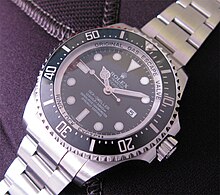
Rolex Sea Dweller Deepsea with 3,900 m depth rating (ref. 116660) Rolex produced specific models suitable for the extremes of deep-sea diving, caving, mountain climbing, polar exploration, and aviation. Early professional models included the Rolex Submariner (1953) and the Rolex Sea Dweller (1967). The latter watch has a helium release valve to release helium gas build-up during decompression, which, according to Urs Alois Eschle, a former Director of Doxa, was patented by Rolex in cooperation with Doxa.[42]
The Explorer (1953) and Explorer II (1971) were developed specifically for explorers who would navigate rough terrain, such as the world-famous Mount Everest expeditions. Indeed, the Rolex Explorer was launched to celebrate the successful ascent of Everest in 1953 by the expeditionary team led by Sir John Hunt. (That expedition was supplied with watches from both Rolex and Smiths; it was a Smiths watch, rather than a Rolex, which Sir Edmund wore to the summit.)[43]
The 39 mm Rolex Explorer was designed as a "tool watch" for rugged use, hence its movement has Paraflex shock absorbers which give them higher shock resistance than other Rolex watches.[39] The 42mm Rolex Explorer II has some significant differences from the 39mm Explorer; the Explorer II adds a date function, and an orange 24-hour hand which is paired with the fixed bezel's black 24-hour markers[44] for situations underground or around the poles where day cannot be distinguished from night.
Another iconic model is the Rolex GMT Master (1955), originally developed at the request of Pan Am Airways to provide its crews with a dual-time watch that could be used to display local time and GMT (Greenwich Mean Time), which was the international time standard for aviation at that time (and still is in its modern variant of Universal Time Coordinated (UTC) or Zulu Time) and was needed for astronavigation (celestial navigation) during longer flights.[11]
Most expensive pieces[edit]
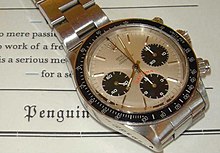
Rolex Daytona chronograph stainless steel, silver dial (ref. 6263) - On 26 October 2017....., a Rolex Daytona (Ref. 6239) wristwatch, manufactured in 1968, was sold by Phillips in its New York auction for US$17.75 million.[45][46][47] The watch was originally purchased by Joanne Woodward in 1968 and was given by Joanne to her husband Paul Newman as a gift.[48] The auction price set a record at $15.5 million, plus buyer's premium of 12.5%, for a final price of $17,752,500 in New York City.[49] As of 2018, it is the most expensive wristwatch and the second most expensive watch ever sold at auction.[47][50][51] Notably, "[a]t the time that Newman gave the watch to James Cox [as a gift], the watch was selling for about $200."[52][53]
- On 28 May 2018, a Rolex Daytona "Unicorn" Ref. 6265 was sold in auction by Phillips for US$5.937 million in Geneva, making it the second most expensive Rolex timepiece ever sold at auction (as of 2018).[54][55]
- The most expensive Rolex (in terms of retail price) ever produced by the Rolex factory was the GMT Ice reference 116769TBR with a retail price of US$485,350.[56]
Sponsorship[edit]
Since 1976, the Rolex Awards for Enterprise of 100,000 Swiss francs has been awarded; a Young Laureates award of 50,000 was added in 2010.[57] The biennial Rolex Mentor and Protégé Arts Initiative with a grant of about $41,000 was launched in 2002.[58]
Rolex has been the official timekeeper to the Le Mans 24 Hours motor race since 2001.[59] Former Formula 1 driver Jackie Stewart has advertised Rolex since 1968. Others who have done so for some years include Gary Player, Arnold Palmer, Roger Penske, Jean-Claude Killy, and Kiri Te Kanawa.[60] It is also the sponsor of the Rolex International Jumping Riders Club Top 10 Final competition.[61]
Jacques Piccard and Don Walsh had a specially designed experimental Rolex Oyster Perpetual Deep-Sea Special strapped to the outside of their bathyscaphe during the 1960 Challenger Deep dive to a world-record depth of 10,916 metres (35,814 ft).[62] When James Cameron conducted a similar dive in 2012, a specially designed and manufactured Rolex Oyster Perpetual Sea-Dweller Deep Sea Challenge watch was being "worn" by his submarine's robotic arm.[63]
Mercedes Gleitze was the first British woman to swim the English Channel on 7 October 1927. However, as John E. Brozek (author of The Rolex Report: An Unauthorized Reference Book for the Rolex Enthusiast) points out in his article "The Vindication Swim, Mercedes Gleitze and Rolex take the plunge", some doubts were cast on her achievement when a hoaxer claimed to have made a faster swim only four days later. Hence Gleitze attempted a repeat swim with extensive publicity on 21 October, dubbed the "Vindication Swim". For promotional purposes, Wilsdorf offered her one of the earliest Rolex Oysters if she would wear it during the attempt. After more than 10 hours, in water that was much colder than during her first swim, she was pulled from the sea semi-conscious seven miles short of her goal. Although she did not complete the second crossing, a journalist for The Times wrote, "Having regard to the general conditions, the endurance of Miss Gleitze surprised the doctors, journalists and experts who were present, for it seemed unlikely that she would be able to withstand the cold for so long. It was a good performance." As she sat in the boat, the same journalist made a discovery and reported it as follows: "Hanging round her neck by a ribbon on this swim, Miss Gleitze carried a small gold watch, which was found this evening to have kept good time throughout." When examined closely, the watch was found to be dry inside and in perfect condition. One month later, on 24 November 1927, Wilsdorf launched the Rolex Oyster watch in the United Kingdom with a full front page Rolex advertisement in the Daily Mail.
Achievements[edit]
Among the company's notable improvements and innovations are:
- In 1926, Rolex produced the Oyster case. While they claim this was the first reliable waterproof wristwatch case based on a screw-down crown it was not; Depollier's case was patented 8 years earlier.[64] To this end, Rolex acquired the Perragaux-Perret screw-down patent, added a clutch and combined the screw-down crown with a threaded case back and bezel.[65] Wilsdorf even had a specially made Rolex watch (the watch was called the "DeepSea") attached to the side of Trieste, which went to the bottom of the Mariana Trench. The watch survived and tested as having kept perfect time during its descent and ascent. This was confirmed by a telegram sent to Rolex the following day saying "Am happy to confirm that even at 11,000 metres your watch is as precise as on the surface. Best regards, Jacques Piccard".[11] Earlier waterproof watches such as the "Submarine Watch" by Tavannes used other means to seal the case.
- In 1910, the first watchmaker to earn chronometer certification for a small lady wristwatch.[11]
- In 1931, released a wristwatch winding mechanism featuring a rotor, a full 360 degrees rotating weight to power the watch by the movement of the wearer's arm.[66] As well as making watch winding unnecessary, it also kept the power from the mainspring more consistent, resulting in more reliable timekeeping. Fully rotating weights later became part of the standard winding mechanism of self-winding wristwatches. A preceding self-winding mechanism by Harwood instead used a weight that moved in a 270 degrees arc hitting buffer springs on both sides.[67]
- In 1945, introduced the first chronometer wristwatch with an automatically changing date on the dial (Rolex Datejust Ref. 4467).[17] An earlier wristwatch with a date changing mechanism by Mimo was not chronometer certified.
- In 1953, released a case waterproof to 100 m (330 ft) in the Rolex Oyster Perpetual Submariner Ref. 6204. Although this has been commonly publicized as the first diving watch, in 1932 Omega had released the Marine, which could stand 135mts, 35mts more than the 1953 Rolex Submariner. Blancpain produced their Fifty Fathoms watch in 1953, 10 months before the Rolex Submariner.[68]
- In 1954, produced a wristwatch which showed two time zones at once in the Rolex GMT Master ref. 6542.[69] Yet again, it was not the first company to do so, as the Longines DualTime preceded the GMT by a full quarter of a century.[70]
- In 1956, Rolex made a wristwatch with an automatically changing day and date on the dial in the Rolex Day-Date.[71]
Cultural impact[edit]
By the start of World War II, Royal Air Force pilots were buying Rolex watches to replace their inferior standard-issue watches; however, when captured and sent to prisoner of war (POW) camps, their watches were confiscated.[17] When Hans Wilsdorf heard of this, he offered to replace all watches that had been confiscated and not require payment until the end of the war, if the officers would write to Rolex and explain the circumstances of their loss and where they were being held. Wilsdorf was in personal charge of the scheme.[72][73] As a result of this, an estimated 3,000 Rolex watches were ordered by British officers in the officer camp Oflag VII-B in Bavaria alone.[72] This had the effect of raising the morale among the allied POWs because it indicated that Wilsdorf did not believe that the Axis powers would win the war.[72][74] American servicemen heard about this when stationed in Europe during WWII and this helped open up the American market to Rolex after the war.[17]
On 10 March 1943, while still a prisoner of war, Corporal Clive James Nutting, one of the organizers of the Great Escape, ordered a stainless steel Rolex Oyster 3525 Chronograph (valued at a current equivalent of £1,200) by mail directly from Hans Wilsdorf in Geneva, intending to pay for it with money he saved working as a shoemaker at the camp.[72][74][75] The watch (Rolex watch no. 185983)[75][76] was delivered to Stalag Luft III on 10 July that year along with a note from Wilsdorf apologising for any delay in processing the order and explaining that an English gentleman such as Corporal Nutting "should not even think" about paying for the watch before the end of the war.[72][74] Wilsdorf is reported to have been impressed with Nutting because, although not an officer, he had ordered the expensive Rolex 3525 Oyster chronograph while most other prisoners ordered the much cheaper Rolex Speed King model which was popular because of its small size.[72] The watch is believed to have been ordered specifically to be used in the Great Escape when, as a chronograph, it could have been used to time patrols of prison guards or time the 76 ill-fated escapees through tunnel 'Harry' on 24 March 1944.[72][74][77] Eventually, after the war, Nutting was sent an invoice of only £15 for the watch, because of currency export controls in England at the time.[74] The watch and associated correspondence between Wilsdorf and Nutting were sold at an auction for £66,000 in May 2007, while at an earlier auction in September 2006 the same watch fetched A$54,000.[74][76] Nutting served as a consultant for both the 1950 film The Wooden Horse and the 1963 film The Great Escape.[72]
In a famous murder case, the Rolex on Ronald Platt's wrist eventually led to the arrest of his murderer,
Prince of Persia: The Two Thrones versionD
Prince of Persia: The Two Thrones versionD theme by Deemy
Download: POPTheTwoThrones_versionD.p3t
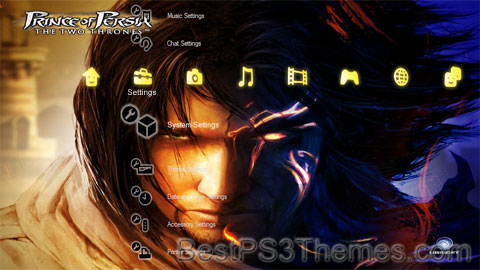
(14 backgrounds)
P3T Unpacker v0.12
Copyright (c) 2007. Anoop MenonThis program unpacks Playstation 3 Theme files (.p3t) so that you can touch-up an existing theme to your likings or use a certain wallpaper from it (as many themes have multiple). But remember, if you use content from another theme and release it, be sure to give credit!
Download for Windows: p3textractor.zip
Instructions:
Download p3textractor.zip from above. Extract the files to a folder with a program such as WinZip or WinRAR. Now there are multiple ways to extract the theme.
The first way is to simply open the p3t file with p3textractor.exe. If you don’t know how to do this, right click the p3t file and select Open With. Alternatively, open the p3t file and it will ask you to select a program to open with. Click Browse and find p3textractor.exe from where you previously extracted it to. It will open CMD and extract the theme to extracted.[filename]. After that, all you need to do for any future p3t files is open them and it will extract.
The second way is very simple. Just drag the p3t file to p3textractor.exe. It will open CMD and extract the theme to extracted.[filename].
For the third way, first put the p3t file you want to extract into the same folder as p3textractor.exe. Open CMD and browse to the folder with p3extractor.exe. Enter the following:
p3textractor filename.p3t [destination path]Replace filename with the name of the p3t file, and replace [destination path] with the name of the folder you want the files to be extracted to. A destination path is not required. By default it will extract to extracted.filename.Eye of Judgment Water
Eye of Judgment (Judgement) Water theme by Xehos
Download: EyeofJudgmentWater.p3t
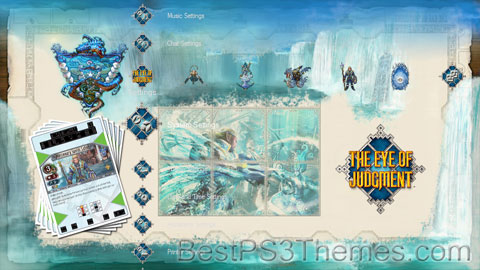
(4 backgrounds)
P3T Unpacker v0.12
Copyright (c) 2007. Anoop MenonThis program unpacks Playstation 3 Theme files (.p3t) so that you can touch-up an existing theme to your likings or use a certain wallpaper from it (as many themes have multiple). But remember, if you use content from another theme and release it, be sure to give credit!
Download for Windows: p3textractor.zip
Instructions:
Download p3textractor.zip from above. Extract the files to a folder with a program such as WinZip or WinRAR. Now there are multiple ways to extract the theme.
The first way is to simply open the p3t file with p3textractor.exe. If you don’t know how to do this, right click the p3t file and select Open With. Alternatively, open the p3t file and it will ask you to select a program to open with. Click Browse and find p3textractor.exe from where you previously extracted it to. It will open CMD and extract the theme to extracted.[filename]. After that, all you need to do for any future p3t files is open them and it will extract.
The second way is very simple. Just drag the p3t file to p3textractor.exe. It will open CMD and extract the theme to extracted.[filename].
For the third way, first put the p3t file you want to extract into the same folder as p3textractor.exe. Open CMD and browse to the folder with p3extractor.exe. Enter the following:
p3textractor filename.p3t [destination path]Replace filename with the name of the p3t file, and replace [destination path] with the name of the folder you want the files to be extracted to. A destination path is not required. By default it will extract to extracted.filename.Graffiti
Graffiti theme by Jabyaeye
Download: Graffiti.p3t
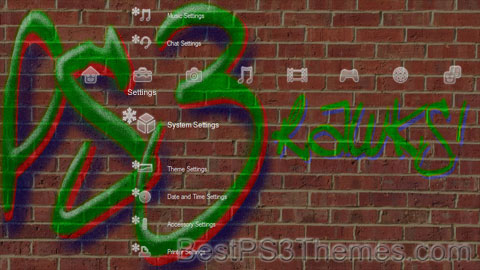
(2 backgrounds)
 This article possibly contains original research. (March 2019)
This article possibly contains original research. (March 2019)
An abandoned roof felt factory with graffiti in Santalahti, Tampere, Finland Graffiti (plural; singular graffiti or graffito, the latter rarely used except in archeology) is art that is written, painted or drawn on a wall or other surface, usually without permission and within public view.[1][2] Graffiti ranges from simple written "monikers" to elaborate wall paintings, and has existed since ancient times, with examples dating back to ancient Egypt, ancient Greece, and the Roman Empire (see also mural).[3]
Graffiti is a controversial subject. In most countries, marking or painting property without permission is considered by property owners and civic authorities as defacement and vandalism, which is a punishable crime, citing the use of graffiti by street gangs to mark territory or to serve as an indicator of gang-related activities.[4] Graffiti has become visualized as a growing urban "problem" for many cities in industrialized nations, spreading from the New York City subway system and Philadelphia in the early 1970s to the rest of the United States and Europe and other world regions.[5]
Etymology[edit]
Ancient graffito in the Kom Ombo Temple, Egypt "Graffiti" (usually both singular and plural) and the rare singular form "graffito" are from the Italian word graffiato ("scratched").[6][1][2] The term "graffiti" is used in art history for works of art produced by scratching a design into a surface. A related term is "sgraffito",[7] which involves scratching through one layer of pigment to reveal another beneath it. This technique was primarily used by potters who would glaze their wares and then scratch a design into them. In ancient times graffiti were carved on walls with a sharp object, although sometimes chalk or coal were used. The word originates from Greek γράφειν—graphein—meaning "to write".[8]
History[edit]

Ancient Pompeii graffito caricature of a politician. Villa of the Mysteries. 
Figure graffito, similar to a relief, at the Castellania, in Valletta The term graffiti originally referred to the inscriptions, figure drawings, and such, found on the walls of ancient sepulchres or ruins, as in the Catacombs of Rome or at Pompeii. Historically, these writings were not considered vandalism,[9] which today is considered part of the definition of graffiti.[10]
The only known source of the Safaitic language, an ancient form of Arabic, is from graffiti: inscriptions scratched on to the surface of rocks and boulders in the predominantly basalt desert of southern Syria, eastern Jordan and northern Saudi Arabia. Safaitic dates from the first century BC to the fourth century AD.[11][12]
Ancient graffiti[edit]
Some of the oldest cave paintings in the world are 40,000 year old ones found in Australia.[9] The oldest written graffiti was found in ancient Rome around 2500 years ago.[13] Most graffiti from the time was boasts about sexual experiences.[14] Graffiti in Ancient Rome was a form of communication, and was not considered vandalism.[9]
Ancient tourists visiting the 5th-century citadel at Sigiriya in Sri Lanka write their names and commentary over the "mirror wall", adding up to over 1800 individual graffiti produced there between the 6th and 18th centuries.[15] Most of the graffiti refer to the frescoes of semi-nude females found there. One reads:
Wet with cool dew drops
fragrant with perfume from the flowers
came the gentle breeze
jasmine and water lily
dance in the spring sunshine
side-long glances
of the golden-hued ladies
stab into my thoughts
heaven itself cannot take my mind
as it has been captivated by one lass
among the five hundred I have seen here.[16]Among the ancient political graffiti examples were Arab satirist poems. Yazid al-Himyari, an Umayyad Arab and Persian poet, was most known for writing his political poetry on the walls between Sajistan and Basra, manifesting a strong hatred towards the Umayyad regime and its walis, and people used to read and circulate them very widely.[17][clarification needed]
Graffiti, known as Tacherons, were frequently scratched on Romanesque Scandinavian church walls.[18] When Renaissance artists such as Pinturicchio, Raphael, Michelangelo, Ghirlandaio, or Filippino Lippi descended into the ruins of Nero's Domus Aurea, they carved or painted their names and returned to initiate the grottesche style of decoration.[19][20]
There are also examples of graffiti occurring in American history, such as Independence Rock, a national landmark along the Oregon Trail.[21]
- Ancient graffiti
-
Graffiti from the Museum of Ancient Graffiti (fr), France
-
Ironic wall inscription commenting on boring graffiti
-
Satirical Alexamenos graffito, possibly the earliest known representation of Jesus
-
Graffiti, Church of the Holy Sepulchre, Jerusalem
-
Crusader graffiti in the Church of the Holy Sepulchre
Contemporary graffiti[edit]
Later, French soldiers carved their names on monuments during the Napoleonic campaign of Egypt in the 1790s.[22] Lord Byron's survives on one of the columns of the Temple of Poseidon at Cape Sounion in Attica, Greece.[23]
The oldest known example of graffiti monikers found on traincars created by hobos and railworkers since the late 1800s. The Bozo Texino monikers were documented by filmmaker Bill Daniel in his 2005 film, Who is Bozo Texino?.[24][25]
In World War II, an inscription on a wall at the fortress of Verdun was seen as an illustration of the US response twice in a generation to the wrongs of the Old World:[26][27]
Austin White – Chicago, Ill – 1918
Austin White – Chicago, Ill – 1945
This is the last time I want to write my name here.During World War II and for decades after, the phrase "Kilroy was here" with an accompanying illustration was widespread throughout the world, due to its use by American troops and ultimately filtering into American popular culture. Shortly after the death of Charlie Parker (nicknamed "Yardbird" or "Bird"), graffiti began appearing around New York with the words "Bird Lives".[28]
- World War II graffiti
-
Soldier with tropical fantasy graffiti (1943–1944)
- Early spray-painted graffiti
-
New York City Subway trains were covered in graffiti (1973).
-
Graffiti in Chicago (1973)
Modern Graffiti[edit]
Modern graffiti art has its origins with young people in 1960s and 70s in New York City and Philadelphia. Tags were the first form of stylised contemporary graffiti. Eventually, throw-ups and pieces evolved with the desire to create larger art. Writers used spray paint and other kind of materials to leave tags or to create images on the sides subway trains.[29] and eventually moved into the city after the NYC metro began to buy new trains and paint over graffiti.[30]
While the art had many advocates and appreciators—including the cultural critic Norman Mailer—others, including New York City mayor Ed Koch, considered it to be defacement of public property, and saw it as a form of public blight.[31] The ‘taggers’ called what they did ‘writing’—though an important 1974 essay by Mailer referred to it using the term ‘graffiti.’[31]
Contemporary graffiti style has been heavily influenced by hip hop culture[32] and the myriad international styles derived from Philadelphia and New York City Subway graffiti; however, there are many other traditions of notable graffiti in the twentieth century. Graffiti have long appeared on building walls, in latrines, railroad boxcars, subways, and bridges.
An early graffito outside of New York or Philadelphia was the inscription in London reading "Clapton is God" in reference to the guitarist Eric Clapton. Creating the cult of the guitar hero, the phrase was spray-painted by an admirer on a wall in Islington, north London, in the autumn of 1967.[33] The graffito was captured in a photograph, in which a dog is urinating on the wall.[34]
Films like Style Wars in the 80s depicting famous writers such as Skeme, Dondi, MinOne, and ZEPHYR reinforced graffiti's role within New York's emerging hip-hop culture. Although many officers of the New York City Police Department found this film to be controversial, Style Wars is still recognized as the most prolific film representation of what was going on within the young hip hop culture of the early 1980s.[35] Fab 5 Freddy and Futura 2000 took hip hop graffiti to Paris and London as part of the New York City Rap Tour in 1983.[36]
Commercialization and entrance into mainstream pop culture[edit]
With the popularity and legitimization of graffiti has come a level of commercialization. In 2001, computer giant IBM launched an advertising campaign in Chicago and San Francisco which involved people spray painting on sidewalks a peace symbol, a heart, and a penguin (Linux mascot), to represent "Peace, Love, and Linux." IBM paid Chicago and San Francisco collectively US$120,000 for punitive damages and clean-up costs.[37][38]
In 2005, a similar ad campaign was launched by Sony and executed by its advertising agency in New York, Chicago, Atlanta, Philadelphia, Los Angeles, and Miami, to market its handheld PSP gaming system. In this campaign, taking notice of the legal problems of the IBM campaign, Sony paid building owners for the rights to paint on their buildings "a collection of dizzy-eyed urban kids playing with the PSP as if it were a skateboard, a paddle, or a rocking horse".[38]
Global developments[edit]
South America[edit]
Tristan Manco wrote that Brazil "boasts a unique and particularly rich, graffiti scene ... [earning] it an international reputation as the place to go for artistic inspiration". Graffiti "flourishes in every conceivable space in Brazil's cities". Artistic parallels "are often drawn between the energy of São Paulo today and 1970s New York". The "sprawling metropolis", of São Paulo has "become the new shrine to graffiti"; Manco alludes to "poverty and unemployment ... [and] the epic struggles and conditions of the country's marginalised peoples", and to "Brazil's chronic poverty", as the main engines that "have fuelled a vibrant graffiti culture". In world terms, Brazil has "one of the most uneven distributions of income. Laws and taxes change frequently". Such factors, Manco argues, contribute to a very fluid society, riven with those economic divisions and social tensions that underpin and feed the "folkloric vandalism and an urban sport for the disenfranchised", that is South American graffiti art.[39]

A graffiti piece by the artist DeDe found in Tel Aviv
Prominent Brazilian writers include Os Gêmeos, Boleta, Nunca, Nina, Speto, Tikka, and T.Freak.[40] Their artistic success and involvement in commercial design ventures[41] has highlighted divisions within the Brazilian graffiti community between adherents of the cruder transgressive form of pichação and the more conventionally artistic values of the practitioners of grafite.[42]
Middle East[edit]
Graffiti in the Middle East has emerged slowly, with taggers operating in Egypt, Lebanon, the Gulf countries like Bahrain or the United Arab Emirates,[43] Israel, and in Iran. The major Iranian newspaper Hamshahri has published two articles on illegal writers in the city with photographic coverage of Iranian artist A1one's works on Tehran walls. Tokyo-based design magazine, PingMag, has interviewed A1one and featured photographs of his work.[44] The Israeli West Bank barrier has become a site for graffiti, reminiscent in this sense of the Berlin Wall. Many writers in Israel come from other places around the globe, such as JUIF from Los Angeles and DEVIONE from London. The religious reference "נ נח נחמ נחמן מאומן" ("Na Nach Nachma Nachman Meuman") is commonly seen in graffiti around Israel.
Graffiti has played an important role within the street art scene in the Middle East and North Africa (MENA), especially following the events of the Arab Spring of 2011 or the Sudanese Revolution of 2018/19.[45] Graffiti is a tool of expression in the context of conflict in the region, allowing people to raise their voices politically and socially. Famous street artist Banksy has had an important effect in the street art scene in the MENA area, especially in Palestine where some of his works are located in the West Bank barrier and Bethlehem.[46]
Southeast Asia[edit]
There are also a large number of graffiti influences in Southeast Asian countries that mostly come from modern Western culture, such as Malaysia, where graffiti have long been a common sight in Malaysia's capital city, Kuala Lumpur. Since 2010, the country has begun hosting a street festival to encourage all generations and people from all walks of life to enjoy and encourage Malaysian street culture.[47]
- Graffiti around the world
-
Graffiti on a wall in Čakovec, Croatia
-
Graffiti in Ho Chi Minh City, Vietnam
-
Graffiti art in Kuala Lumpur, Malaysia
-
Graffiti in Yogyakarta, Indonesia
-
Graffiti on a park wall in Sydney, Australia
-
Graffiti in São Paulo, Brazil
Black and Green
Black and Green theme by Jantsu92
Download: BlackandGreen.p3t
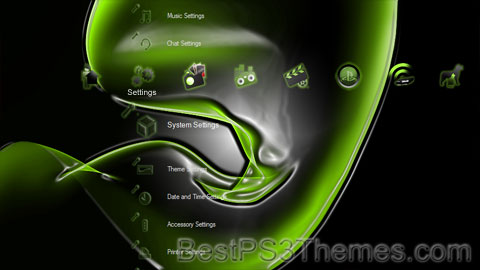
(3 backgrounds)
P3T Unpacker v0.12
Copyright (c) 2007. Anoop MenonThis program unpacks Playstation 3 Theme files (.p3t) so that you can touch-up an existing theme to your likings or use a certain wallpaper from it (as many themes have multiple). But remember, if you use content from another theme and release it, be sure to give credit!
Download for Windows: p3textractor.zip
Instructions:
Download p3textractor.zip from above. Extract the files to a folder with a program such as WinZip or WinRAR. Now there are multiple ways to extract the theme.
The first way is to simply open the p3t file with p3textractor.exe. If you don’t know how to do this, right click the p3t file and select Open With. Alternatively, open the p3t file and it will ask you to select a program to open with. Click Browse and find p3textractor.exe from where you previously extracted it to. It will open CMD and extract the theme to extracted.[filename]. After that, all you need to do for any future p3t files is open them and it will extract.
The second way is very simple. Just drag the p3t file to p3textractor.exe. It will open CMD and extract the theme to extracted.[filename].
For the third way, first put the p3t file you want to extract into the same folder as p3textractor.exe. Open CMD and browse to the folder with p3extractor.exe. Enter the following:
p3textractor filename.p3t [destination path]Replace filename with the name of the p3t file, and replace [destination path] with the name of the folder you want the files to be extracted to. A destination path is not required. By default it will extract to extracted.filename.














